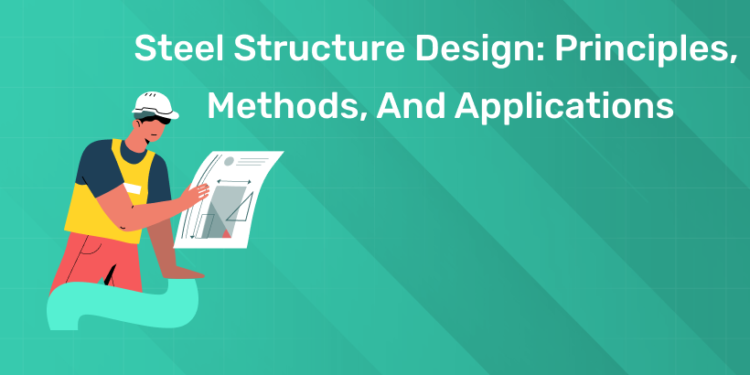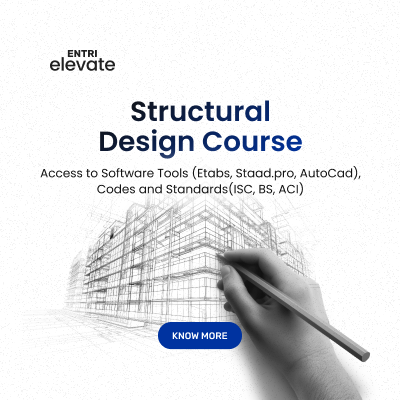Introduction
Steel structure design is a core part of civil and structural engineering. With steel’s strength, durability and flexibility it’s one of the most used material for building, bridges, industrial facilities and other large projects. Steel structure design involves understanding principles, methods and applications that makes structures safe, cost effective and sustainable. In this post we will go through the principles, methods, components and applications of steel structure design and how a structural design course can help aspiring engineers to gain the skills.
Learn Steel Structure Design Course to Elevate Your Career!
Steel Structure Design Principles
Steel structure design is governed by several key principles that ensures strength, stability and efficiency. The main principles are load bearing capacity, ductility, safety and economic feasibility.
1. Load Bearing Capacity
One of the most important principle in steel structure design is load bearing capacityDesigners create structures to bear two types of loads: dead loads (the weight of the structure itself) and live loads (temporary loads like people), furniture and equipment). Additional loads like wind, seismic forces and snow also need to be considered. Engineers calculate the maximum load the structure can take without deformation or collapse.
2. Ductility
Ductility refers to the ability of steel to deform under stress before fracturing which is very important in seismic design. Steel’s ductility allows it to bend and stretch and absorb lot of energy without breaking making it suitable for structures in earthquake prone areas.
3. Safety
Safety is the top priority in steel structure design with strict standards and building codes to ensure structures can withstand various loads and environmental conditions. Steel structures must be designed to resist potential hazards like fire, fatigue, corrosion and mechanical stress.
4. Economic Feasibility
One of the principle in any construction project is economic feasibility. Steel structure design aims to balance safety and functionality with cost. This includes selecting right steel grade, optimizing structural members and minimizing waste during fabrication.
Steel Structure Design Methods
Steel structure design methods are classified into three ways: Allowable Stress Design (ASD), Load and Resistance Factor Design (LRFD) and Plastic Design. Each has its own advantages and is chosen based on project and structural requirements.
1. Allowable Stress Design (ASD)
Allowable Stress Design (ASD) or elastic design is the oldest of the design methods. It calculates the maximum stress a structure can take before it yields. This method considers the yield strength of the steel and applies a safety factor to ensure the structure stays within elastic limits under expected loads.
2. Load and Resistance Factor Design (LRFD)
Load and Resistance Factor Design (LRFD) is a modern method that uses limit state principles to account for load and material uncertainties. LRFD applies load factors (to account for overloads) and resistance factors (to account for material variability). This results in a more efficient and economical design with a sufficient margin of safety.
3. Plastic Design
Plastic design considers the behavior of steel structures beyond their elastic limit, allows them to deform plastically without failure. This is used in structures where large deformations are acceptable, like industrial buildings. Plastic design allows engineers to use the full strength of the material, making it a cost effective solution for some applications.
Steel Structure Components
1. Beams
Beams are horizontal members that carry loads perpendicular to their length. They resist bending and shear forces and transfer loads to the columns. In steel structures, beams come in different shapes like I-beams, T-beams and H-beams depending on the design requirements.
2. Columns
Columns are vertical members that carry loads downwards. They support compressive loads and are key to the stability of the structure. Columns are designed to resist buckling and are often braced by beams and other structural elements to ensure stability.
3. Bracing
4. Trusses
Trusses are groups of beams or bars joined together to form a triangular shape to distribute loads. They are used in roofs, bridges and industrial structures because they are light and strong.
5. Connections
Connections are where different parts of the structure meet. They are critical in steel structure design as they transfer loads from one part to another.
Steel Structure Design Applications
Steel structure design is used in many sectors because of its versatility, strength and sustainability. Here are some of the most common applications:
1. Buildings and Skyscrapers
2. Bridges
Steel is the preferred material for bridge construction because of its durability and can withstand dynamic loads from vehicles and environmental forces.Designers can create steel bridges in different styles, such as truss bridges, arch bridges, and suspension bridges, to meet specific requirements.
3. Industrial Buildings
Steel structures are used in industrial facilities like warehouses, factories and storage units. These structures require large spans and open floor plans which steel can provide. Also steel is fire resistant and easy to expand making it suitable for industrial applications.
4. Sports Stadiums and Arenas
5. Transportation Infrastructure
In transportation infrastructure like airport terminals, railway stations, and parking garages, builders use steel for its durability and capacity to handle heavy loads and constant movement in transportation facilities.
Conclusion
Steel structure design is a part of structural engineering that combines principles, methods and components to create safe, durable and efficient structures. By following design principles such as load carrying capacity, ductility, safety and economic feasibility engineers can ensure the structure meets functional and safety requirements. Design methods like ASD, LRFD and plastic design provides options for different project requirements while components like beams, columns, bracings and trusses provides stability and strength to steel structures.
Learning Steel structure design has many applications – buildings, bridges, industrial facilities, transportation infrastructure. As technology evolves steel remains a sustainable and versatile choice for construction.
For aspiring structural engineers, learning these concepts is crucial. Take the Structural Design Course on Entri and get valuable skills in understanding steel structure design, to prepare yourself for a career in this exciting and essential field. Whether its learning how to choose the right design method, optimise components or apply steel structure design principles, Entri’s course gives you the foundation knowledge you need.
Transform Your Career with Our Structural Design Course!
Unlock Your Potential in Structural Design! Gain expert knowledge in designing robust structures and advance your career in the construction and engineering fields. Limited spots available! 🌟
Know MoreFrequently Asked Questions
What is steel structure design?
Steel structure design involves creating structures like buildings and bridges using steel, focusing on strength, durability, safety, and economic feasibility.
What are the main principles of steel structure design?
Key principles include load-bearing capacity, ductility, safety, and economic feasibility, ensuring that structures are strong, flexible, cost-effective, and safe.
What are the different methods of designing steel structures?
The primary methods are Allowable Stress Design (ASD), Load and Resistance Factor Design (LRFD), and Plastic Design, each with unique approaches to safety and efficiency.
What is Load and Resistance Factor Design (LRFD)?
LRFD is a design method that applies load and resistance factors to account for uncertainties, optimizing safety and material efficiency.
What are the key components of steel structures?
Key components include beams, columns, bracings, trusses, and connections, which together ensure stability, load distribution, and structural integrity.
What are some common applications of steel structure design?
Steel structures are widely used in skyscrapers, bridges, industrial facilities, sports stadiums, and transportation infrastructure like airports and railway stations.
Why is steel preferred in high-rise buildings and skyscrapers?
Steel’s high strength-to-weight ratio and flexibility make it ideal for tall structures, allowing for open spaces and fewer support columns.
What is the role of bracings in steel structures?
Bracings stabilize the structure against lateral forces such as wind and seismic activity, enhancing rigidity and overall safety.
How do beams and columns function in steel structures?
Beams carry loads horizontally and distribute them to columns, while columns provide vertical support and prevent buckling under loads.
Where can I learn more about steel structure design?
Enrolling in a Structural Design Course, like the one offered by Entri, provides in-depth knowledge and skills for a career in structural engineering.














